| |
|
Xiamen Oil Paintings, Wholesale Direct!
|
|
100% hand painted, 100% cotton canvas, 100% money back if not satisfaction. |
|
|
|
|
ART WORKS INDEX
A
B
C
D
E
F
G
H
I
J
K
L
M
N
O
P
Q
R
S
T
U
V
W
X
Y
Z
|
|
ARTISTS INDEX
A
B
C
D
E
F
G
H
I
J
K
L
M
N
O
P
Q
R
S
T
U
V
W
X
Y
Z
|
|
|
|
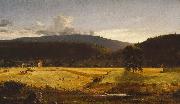 |
Jasper Francis Cropsey
|
|
(February 18, 1823 - April 23, 1900) was an important American landscape artist of the Hudson River School.
Cropsey was born on his father Jacob Rezeau Cropsey's farm in Rossville on Staten Island, New York, the oldest of eight children. As a young boy, Cropsey had recurring periods of poor health. While absent from school, Cropsey taught himself to draw. His early drawings included architectural sketches and landscapes drawn on notepads and in the margins of his schoolbooks.
Trained as an architect, he set up his own office in 1843. Cropsey studied watercolor and life drawing at the National Academy of Design under the instruction of Edward Maury and first exhibited there in 1844. A year later he was elected an associate member and turned exclusively to landscape painting; shortly after he was featured in an exhibition entitled "Italian Compositions."
Cropsey married Maria Cooley in May 1847, traveled in Europe from 1847-1849, visiting England, France, Switzerland, and Italy. He was elected a full member of the Academy in 1851. Cropsey was a personal friend of Henry Tappan, the president of the University of Michigan from 1852 to 1863. At Tappan's invitation, he traveled to Ann Arbor in 1855 and produced two paintings, one of the Detroit Observatory, and a landscape of the campus. He went abroad again in 1855, and resided seven years in London, sending his pictures to the Royal Academy and to the International exhibition of 1862.
Returning home, he opened a studio in New York and specialized in autumnal landscape paintings of the northeastern United States, often idealized and with vivid colors. Cropsey co-founded, with ten fellow artists, the American Society of Painters in Water Colors in 1866. He resided in the City until 1885, when he removed to Hastings-on-Hudson.
The monument of Jasper Francis Cropsey in Sleepy Hollow CemeteryCropsey's home and studio, Ever Rest, in Hastings-on-Hudson, New York as well as the largest permanent collection of Cropsey's work are open for tours by the Newington-Cropsey Foundation.
Jasper Cropsey died in anonymity but was rediscovered by galleries and collectors in the 1960s. Today, Cropsey's paintings are found in most major American museums, including the National Gallery of Art, the Metropolitan Museum of Art, the Los Angeles County Museum of Art, the Detroit Institute of Arts, the Timken Museum of Art in San Diego, the Honolulu Academy of Arts, the Fine Arts Museums of San Francisco, the Denver Art Museum, and the Museum of Fine Arts, Boston. Works by Cropsey also hang in the White House.
|
|
 |
Jasper Cropsey
|
|
American Hudson River School Painter, 1823-1900
Jasper Francis Cropsey (February 18, 1823 - April 23, 1900) was an important American landscape artist of the Hudson River School.
Cropsey was born on his father Jacob Rezeau Cropsey's farm in Rossville on Staten Island, New York, the oldest of eight children. As a young boy, Cropsey had recurring periods of poor health. While absent from school, Cropsey taught himself to draw. His early drawings included architectural sketches and landscapes drawn on notepads and in the margins of his schoolbooks. After studying architecture for five years, he turned his attention to landscape painting, under the instruction of Edward Maury. He visited England, France, Switzerland, and Italy in 1847, went abroad again in 1855, and resided seven years in London, sending his pictures to the Royal Academy and to the International exhibition of 1862.
After his return home in 1863, he opened a studio in New York, where he resided until 1885, when he removed to Hastings-on-Hudson.
Trained as an architect, he set up his own office in 1843. Cropsey studied watercolor and life drawing at the National Academy of Design and first exhibited there in 1844. A year later he was elected an associate member and turned exclusively to landscape painting in the 1840s, shortly after he was featured in an exhibition entitled "Italian Compositions."
Cropsey married Maria Cooley in May 1847, traveled in Europe from 1847-1849, was elected a full member of the Academy in 1851, and lived in England 1856-1863. During this time he specialized in autumnal landscape paintings of the northeastern United States, often idealized and with vivid colors. One such painting is "The Valley of the Wyoming" set in eastern Pennsylvania. The name of this valley was given to the western state of Wyoming.
He co-founded, with ten fellow artists, the American Society of Painters in Water Colors in 1866.
|
|
|
|
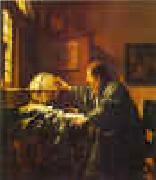 |
JanVermeer
|
|
1632-1675
Johannes (or Jan) Vermeer is now recognized as one of the great Dutch painters, but while he was alive he could barely make ends meet, and his artistic achievement was almost entirely ignored for 200 years after his death. Little is known about his personal life, other than he died poor and young and left behind a wife and eleven children. Vermeer is admired for his realistic style, his subtle use of color and light and his unusual and inventive brush technique, but fewer than forty of his paintings exist. His most famous works include domestic scenes such as Girl With a Peal Earring (1665) and The Music Lesson (1662-65), and tranquil landscapes such as The Little Street (1657-58) and View of Delft (1659-60).
Although his actual birth and death dates are unknown, Vermeer was baptized 31 October 1632 and buried 15 December 1675... During his career he used the names Johannes van der Meer, Johannes Vermeer and Jan Vermeer... He was played by actor Colin Firth in the 2003 film Girl With A Pearl Earring, which also starred Scarlett Johansson as the girl.
|
|
 |
January Suchodolski
|
|
(September 19, 1797 - March 20, 1875) was a Polish painter and Army officer.
Suchodolski was born in Grodno and was the brother of Rajnold Suchodolski.
From 1832 to 1837 Suchodolski studied in Rome, where he was a pupil of Horace Vernet. Suchodolski became known for his history and battle paintings.
He died in Bojmie (near Siedlce).
|
|
 |
Januarius Zick
|
|
German,1730-1797
was a painter and architect. He is considered to be the one of the main masters of the Late-Baroque. Januarius Zick was born in Munich and began to learn his trade from his father, Johannes Zick, a renowned painter himself, to whom he was apprenticed in order to learn how to paint frescoes. In 1744, when Januarius Zick was fourteen years old, his brother, three years his junior, fell to his death from a scaffolding in Weingarten. From 1745 to 1748, Januarius Zick was apprenticed as a bricklayer to Jakob Emele in Schussenried. Having finished his apprenticeship, he worked, together with his father, at the residence of the Prince-Bishop of Wurzburg and then, until the mid-1750s, at the residence of the Prince-Bishop of Speyer in Bruchsal. In 1756, Januarius Zick went to Paris to further his education. There, he came into contact with artists and art connoiseurs from Rome, Basel and Augsburg, who broadened his horizon concerning his art and had a considerable influence on him. After having furnished Castle Engers near Neuwied with frescoes in 1760, he was appointed court painter to the Prince-Elector of Trier, the archbishop of Trier. He married in Ehrenbreitstein and settled there. After 1774, he also designed intarsia paintings for cabinet maker David Roentgen. From the late 1770s on, Januarius Zick was very active in Upper Swabia, furnishing a number of monastery churches and parish churches with frescoes and altarpieces.
|
|
 |
JANSSENS, Jan
|
|
Flemish painter (b. 1590, Ghent, d. after 1650, ?)
Flemish painter, active also in Italy. He became a master in the painters' guild of his native Ghent in 1621, but before that he spent considerable time in Italy, particularly Rome, where he is documented in 1619 and 1620. There he became associated with the international Caravaggesque movement and was especially influenced by the paintings of the Utrecht Caravaggisti, such as Gerrit van Honthorst and Dirck van Baburen. Immediately after his return to Ghent, Janssens introduced the style of Caravaggio there. His altarpieces and other painted compositions with mercilessly realistic representations of biblical and hagiographic themes were particularly sought after for churches in and around Ghent. In these works Janssens achieved a high emotional impact by modelling the figures and objects with a strong light from a hidden source. Typical examples are the Christ Crowned with Thorns (1627; Ghent, St Peter) and the Martyrdom of St Barbara (Ghent, St Michael). Such paintings met the demand that sprang from the Counter-Reformation for strongly emotional representations of religious themes. Janssens also occasionally worked for a public that was more international in outlook, as is demonstrated by his Caritas Romana
|
|
 |
JANSSENS, Abraham
|
|
Flemish painter (b. 1575, Antwerpen, d. 1632, Antwerpen).
Flemish painter. He painted historical, religious and mythological subjects, often on a large scale, derived principally from antique sculpture and the art of Michelangelo and Raphael and, to a lesser degree, from certain contemporaries, including the Dutch late Mannerists and the Bolognese school. He was highly esteemed in Antwerp but suffered, then and subsequently, from the inevitable comparison with his contemporary and formidable rival Rubens
|
|
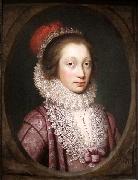 |
Janssens van Ceulen
|
|
Cornelis Janssens van Ceulen (also Cornelius Jonson van Ceulen, Cornelius Johnson, Cornelis Jansz. van Ceulen and many other variants) (bapt. October 14, 1593, London - bur. August 5, 1661, Utrecht) was an English painter of portraits of Dutch or Flemish parentage. He has been described as "one of the most gifted and prolific portrait painters practising in England during the 1620s and 1630s".
|
|
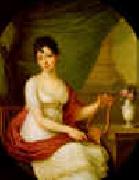 |
Janos Donat
|
|
1744-1830
Hungarian
Janos Donat Location
Donat was born in Klosterneuzell in 1744 and learned painting at M. Meytens, V. Fischer and Sambach in Vienna where he lived for some time and later Prague. In Vienna he became interested in painting portraits. After moving to Pest in 1810 he painted some of his most noted classicist portraits such as Ferenc Kazinczy in 1812 and Benedek Virag in 1815.
He was also noted for his compositions such as Resting Venus, Orfeus and Euridike, and Proserpina which were paintings of mythological creatures.
|
|
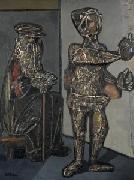 |
Jankel Adler
|
|
(July 26, 1895 ?C April 25, 1949) was a Polish painter and printmaker.
He was born as the seventh of ten children in Tuszyn, a suburb of Ł??dź. In 1912 he began training as an engraver with his uncle in Belgrade. He moved in 1914 to Germany where he lived for a time with his sister in Barmen. There he studied at the college of arts and crafts with professor Gustav Wiethecher.
From 1918-1919 he went back to Ł??dź, where he was joint founder of a group of avant-garde artists. In 1920 he returned briefly to Berlin; in 1921 he returned to Barmen, and in 1922 he moved to Desseldorf. There he became a teacher at the Academy of Arts, and became acquainted with Paul Klee, who influenced his work. A painting by Adler received a gold medal at the exhibition German art Desseldorf in 1928.
In 1929 and 1930 he went on study trips in Mallorca and other places in Spain. During the election campaign of July 1932 he published with a group of leftist artists and intellectuals an urgent appeal against the policy of the National Socialists and for communism. As a modern artist, and especially as a Jew, he faced persecution under Hitler's regime which took power in 1933.
|
|
 |
Janis Rozentals
|
|
(March 18, 1866, Bebri Farmstead, Saldus parish, Courland Governorate - December 26, 1916) was a Latvian painter.
Rozentels received the basic education at H.Krause's Elementary School in Saldus and Kuldega District School. At the age of fifteen the boy left for Riga and consistently tried to realize his dream about art, later entering St.Petersburg Academy of Art. During study vacations the developing artist visited his native land to relax from the hectic rhythm of the large city, paint motifs from nature and commissioned portraits. For his diploma work he took as models the young educated Latvians and local farmers. A little later the artist decided to settle in Saldus as he wanted to live among his people and create art appropriate to its aspirations and feelings. In spring 1899 Rozentels bought a building plot at the Striķu street and set up a studio, but his intents were not well received in the provincial town and he moved to Riga two years later. Now a memorial museum is arranged in the building designed by the artist. Fateful turn in life of the painter happened in November, 1902, when Janis Rozentels got acquainted with Elli Forsell(1871 - 1943), a Finnish singer, in Riga. On February 20, 1903, they got married. They found home in a flat- studio, in Alberta street, in Riga. they had three children - Laila, Irja and Miķelis. World War I interrupted the family's life in Riga and in 1915 they relocated to Finland. He died suddenly on December 26, 1916 and was buried in Helsinki, though later was reburied in his homeland. Today, the Janis Rozentels Art Highschool in Riga is named after him, and has had his name since 1946.
|
|
 |
Jane Sutherland
|
|
Australian, 1853-1928, Australian painter. She was the eldest daughter of George Sutherland (1829-85), a carver, music teacher and artist who moved with his family to Australia from Glasgow in 1864, settling in Melbourne in 1870. She attended the National Gallery School from 1871 to 1885 and was awarded the R. Wallen Prize in 1883. From mid-1888 she occupied a studio with Clara Southern and gave art lessons in Grosvenor Chambers, Collins Street
|
|
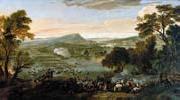 |
Jan Wyck
|
|
Dutch Baroque Era Painter, 1652-1700,Son of Thomas Wijck. A marriage certificate issued on 22 November 1676 describes the artist as 'Jan Wick of St Paul's Covent Garden, gent., widower, about 31 ...', suggesting that he was born c. 1645, but his correct birthdate is known from the inscription on a mezzotint portrait of him by John Faber II (1684-1756) after a painting by Sir Godfrey Kneller. Jan is first documented on 17 June 1674, when he appeared before the court of the Painter-Stainers' Company in London and vowed to pay both his own and his father's quarterly fees. The certificate of 1676 relates to his second marriage, to Ann Skinner (d 1687), who between 1678 and 1683 bore him four children, all of whom died young. After Ann's death in 1687, he married Elizabeth Holomberg (d 1693) in 1688 and moved to Mortlake. Between 1689 and 1693 they had two sons and a daughter.
|
|
|
|
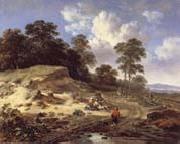 |
Jan Wijnants
|
|
Dutch, born circa 1635-1684,was a Dutch painter of the Baroque era. He was the son an art dealer also named Jan Wijnants. After his mother's death, his father remarried Maria Jans van Stralen, widow of Jasper Jaspersz van Heemskerck, and mother of the painter Egbert Jaspersz van Heemskerck, making Wijnant and Van Heemskerck stepbrothers. Wijnants was active in Haarlem until 1660, after which he moved to Amsterdam.
Wijnants is primarily known for his landscapes and paintings featuring topography. Adriaen van de Velde trained in his studio and his style later had influence on the English artist, Thomas Gainsborough.
|
|
|
|
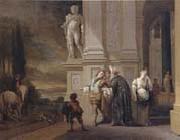 |
Jan Weenix
|
|
Dutch Baroque Era Painter ,
Amsterdam 1640/42-1719
Painter and draughtsman, son of (1) Jan Baptist Weenix. Jan probably received his first instruction as a painter from his father, and it is possible that he helped finish certain of his father's works. He probably remained in Utrecht after his father's death. By 1664 he had become a member of the Guild of St Luke in Utrecht without, however, having submitted the required entrance painting, which he provided by 1668. There are several documented references to Jan in the late 1660s. He inherited a legacy along with his uncle, the painter Barent Micker, and other family members in 1667, at which time Gillis, his younger brother, apparently still required a guardian. He received another legacy in 1668, the year of his marriage, and in 1669 served as a witness for the inventory of the painter Jacob de Hennin (1629-c. 1688) in The Hague.
|
|
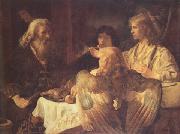 |
Jan victors
|
|
Dutch Baroque Era Painter, ca.1619-1676
was a Dutch Baroque painter that focused mainly on painting subject from the Bible. He was a student of Rembrandt van Rijn.
|
|
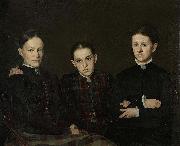 |
Jan Veth
|
|
(18 May 1864 Dordrecht - 1 July 1925 Amsterdam), was a Dutch painter, poet, art critic and university lecturer.
Jan Veth was the son of Gerradus Huibert Veth, a Dordrecht iron merchant and liberal politician, and Anna Cornelia Giltay. On his mother's side he descended from the Dordrecht painter family of Van Strij (his mother was a granddaughter of Jacob van Strij). He married Anna Dorothea Dirks on 10 August 1888, from which marriage came five children.
Veth received his art education at the Rijksakademie voor Beeldende Kunsten in Amsterdam. With several of his fellow students he founded the St. Luke group. From 1885 he worked with the painter Anton Mauve in Laren. After his marriage in 1888 he settled in Bussum.
Jan Veth is especially noted as a portrait painter. Amongst his sitters were Max Liebermann, Lambertus Zijl, Frank van der Goes, Antoon Derkinderen and other contemporaries including various fellow painters.
In addition he was a well-known poet, belonging to the Eighties movement and publishing work in the De Nieuwe Gids. He designed the cover for "De Kleine Johannes", a book written by his friend, Frederik van Eeden, contributing to the development of book-art in Holland.
As Professor Extraordinary in History of Art and Aesthetics, he was associated with the Rijksakademie voor Beeldende Kunsten in Amsterdam.
|
|
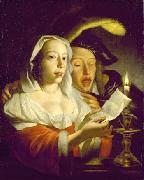 |
Jan Vermeer van Utrecht
|
|
(bapt. 16 February 1630, Schipluiden - c. 1696, Vreeswijk), was a Dutch Golden Age painter. Though he was born near Delft, there is no known relation between this painter and Johannes Vermeer.
His father died when he was 10 and he was raised by his step-grandfather in Rotterdam. According to Houbraken he travelled to Italy with Lieve Verschuier and became friends with Willem Drost and Johann Carl Loth.
He returned North in 1662, where he became member of the Utrecht Guild of St. Luke in 1663 and became deacon of the guild 1664-1666.Houbraken tells a curious story about Vermeer van Utrecht in his biography of Jan Davidsz de Heem. In this story, on his return from Italy, Vermeer marries a widow who owns a white lead factory. He is wealthy and has a carefree life until his wife dies and then his factory is burned by French soldiers. He manages to save a garland painting by De Heem that he once paid 2000 guilders for. This was an enormous sum of money, but Houbraken mentions that his grandfather had been a wealthy man, and until his factory was destroyed, Vermeer van Utrecht had been painting for pleasure, rather than professionally. The amount is meant as an indication of the fame and esteem of De Heem, rather than the wealth of Vermeer van Utrecht. Vermeer van Utrecht then applies to his benefactor, Frederick Nassau de Zuylestein, to give him a government post in return for this painting, which he offers to paint with the likeness of the young prince Willem III in the middle of the garland. The lord of Zuylestein was the governor of the young prince from 1659 to 1666, so this deal must have been done sometime between 1662 (Vermeer van Utrecht's return from Italy), and 1672 (the death of the lord of Zuylestein). Apparently, the deal is done, and several years pass, in which Vermeer van Utrecht did become an appointed member of the Utrecht regency (Vroedschap), but where he felt like a fifth wheel. In 1672 the Utrecht council takes pity on him, and gave him the post of Toll-collector and controller of the river lock at Vreeswijk, where he later remarried.
|
|
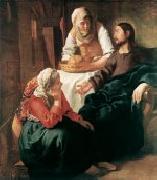 |
Jan Vermeer
|
|
Dutch Baroque Era Painter, 1632-1675
Johannes (or Jan) Vermeer is now recognized as one of the great Dutch painters, but while he was alive he could barely make ends meet, and his artistic achievement was almost entirely ignored for 200 years after his death. Little is known about his personal life, other than he died poor and young and left behind a wife and eleven children. Vermeer is admired for his realistic style, his subtle use of color and light and his unusual and inventive brush technique, but fewer than forty of his paintings exist. His most famous works include domestic scenes such as Girl With a Peal Earring (1665) and The Music Lesson (1662-65), and tranquil landscapes such as The Little Street (1657-58) and View of Delft (1659-60). Although his actual birth and death dates are unknown, Vermeer was baptized 31 October 1632 and buried 15 December 1675... During his career he used the names Johannes van der Meer, Johannes Vermeer and Jan Vermeer
|
|
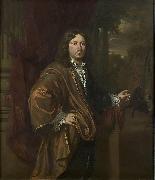 |
Jan Verkolje
|
|
(Amsterdam, baptized on 27 February 1650 - Delft, 8 May 1693) was a Dutch Golden Age painter and engraver, often called Jan I to distinguish him from his son Jan II. He is known for his portraits and genre pieces.
|
|
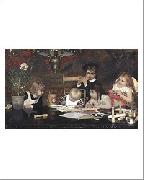 |
Jan Verhas
|
|
(9 January 1834-31 October 1896) was a genre painter and is considered the founder of the School of Dendermonde, best known for his paintings of children of the Belgian bourgeoisie, in a classical style but with a natural feeling to them. Born in Dendermonde as the younger brother of painter Frans Verhas, he studied at the Academy of Dendermonde and the Academy in Antwerp, finishing with the Belgian Prix de Rome in 1860. The Belgian government commissioned him to travel to Venice where he made the painting "Velleda et la Bataille de Callao" in 1862. The next four years, he lived in Binche, where he married. He then moved to Brussels. Verhas was a regular of the Salons of the time, winning a second class medal in the Paris Salon Exposition of 1881, and a gold medal at the 1889 Exposition Universelle. He was made a Chevalier in the Legion of Honor in 1881. Jan Verhas died in Schaarbeek in 1896.
Paintings by Jan Verhas can be seen at the Museum of Fine Arts in Ghent, the Royal Museum of Fine Arts, Antwerp and the City Hall of Dendermonde.
|
|
|
|
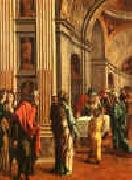 |
Jan van Scorel
|
|
Dutch
1495-1562
Jan Van Scorel Galleries
Jan van Scorel (1495, Schoorl - December 6, 1562, Utrecht) was an influential Dutch painter credited with the introduction of High Italian Renaissance art to the Netherlands. It is not known whether he began his studies under Jan Gossaert in Utrecht or with Jacob Cornelisz in Amsterdam, but it certain that it was the master painters he would meet later in his life who would have the greatest effect on his technique. Van Scorel began traveling through Europe in his early twenties, first heading to Nuremberg and then to Austria. It was there, in 1520, that he completed his first representative work, the "Sippenaltar" in St. Martin's church in the village of Obervellach. Giorgione served as a considerable influence on van Scorel during a tenure in Venice. Upon leaving Venice, van Scorel passed through Rome and made a pilgrimage to the Holy Land. His experiences in Jerusalem are depicted in many of his later works.
In 1521, van Scorel returned to Rome where he met Pope Adrian VI, who appointed him painter to the Vatican. He himself sat for a portrait. Van Scorel enjoyed the influence of Michelangelo and Raphael, and succeeded Raphael as Keeper of the Belvedere.
Upon his return to the Netherlands in 1524, he settled in Haarlem where he began a successful career as a painter and a teacher. Van Scorel was a very educated man and skilled as an engineer and an architect, as well as an artist. He was also multi-lingual, no doubt as a result of his travels.
Considered to be the leading Netherlandish Romanist, van Scorel moved to Ghent for painting contracts before moving to Utrecht for the same reason, where he died in 1562, leaving behind a wealth of portraits and altarpieces. Though many of his works fell victim to the Iconoclasm in 1566, some still remain and can be seen primarily at museums in the Netherlands.
|
|
|
|
|
|
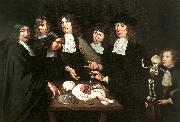 |
jan van neck
|
|
(1634-1714), was a Dutch Golden Age painter. Biography. He was born in Naarden and became a painter, draftsman, engraver, and interior
|
|
|
|
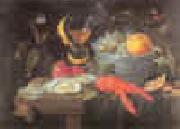 |
Jan Van Kessel
|
|
1626-1679
Dutch
Jan Van Kessel Gallery
Dutch painter and draughtsman. He was a follower, and probably a pupil, of Jacob van Ruisdael and covered the same range of subjects painted by Ruisdael, with the exception of marine paintings. However, van Kessel is best known for his townscapes and panoramic views, as exemplified by the Sluice and the New City Ramparts of Amsterdam in Winter (Amsterdam, Hist. Mus.) and the Bleaching Grounds near Haarlem (Brussels, Mus. A. Anc.). He imitated the water-mills and village scenes of his friend Meindert Hobbema, as well as the waterfalls of Allaert van Everdingen, the wooded landscapes of Jan Wijnants and the winter scenes of Jan van de Cappelle. Many of van Kessel's 120 surviving pictures, including The Avenue (Stuttgart, Staatsgal.) and the Ford in the Woods (Dresden, Gem?ldegal. Alte Meister), were once attributed to van Ruisdael and these other masters (often with an authentic signature covered by the better-known name). Van Kessel is also frequently confused with other minor artists in van Ruisdael's circle, especially Jan Vermeer van Haarlem the younger, Isaac Koene (1637/40-1713), Jacob Salomonsz. van Ruysdael (1629/30-1681) and Anthonie van Borssom. As a draughtsman, van Kessel emulated van Ruisdael's mature style, working almost exclusively in black chalk and grey wash. The best of his 70 drawings are townscapes, although his studies of trees and depictions of farmsteads are noteworthy. A number of correlations exist between his sketches and paintings. There is no known relationship with the Flemish artists of the same name.
|
|
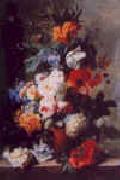 |
Jan van Huysum
|
|
1682-1749
Dutch
Jan Van Huysum Galleries
He was the brother of Jacob van Huysum, and the son of Justus van Huysum, who is said to have been expeditious in decorating doorways, screens and vases. A picture by Justus is preserved in the gallery of Brunswick, representing "Orpheus and the Beasts in a wooded landscape", and here we have some explanation of his son's fondness for landscapes of a conventional and Arcadian kind; for Jan van Huysum, though skilled as a painter of still life, believed himself to possess the genius of a landscape painter.
Half his pictures in public galleries are landscapes, views of imaginary lakes and harbours with impossible ruins and classic edifices, and woods of tall and motionless trees-the whole very glossy and smooth, and entirely lifeless. The earliest dated work of this kind is that of 1717, in the Louvre, a grove with maidens culling flowers near a tomb, ruins of a portico, and a distant palace on the shores of a lake bounded by mountains.
Some of the finest of van Huysum's fruit and flower pieces have been in English private collections: those of 1723 in the earl of Ellesmere's gallery, others of 1730-1732 in the collections of Hope and Ashburton. One of the best examples is now in the National Gallery, London (1736-1737). No public museum has finer and more numerous specimens than the Louvre, which boasts of four landscapes and six panels with still life; then come Berlin and Amsterdam with four fruit and flower pieces; then St Petersburg, Munich, Hanover, Dresden, the Hague, Brunswick, Vienna, Carlsruhe, Boston and Copenhagen.
|
|
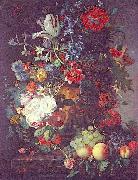 |
Jan van Huijsum
|
|
also spelled Huijsum, (April 15, 1682, Amsterdam - February 8, 1749, Amsterdam) was a Dutch painter.
He was the brother of Jacob van Huysum, the son of the flower painter Justus van Huysum, and the grandson of Jan van Huysum I, who is said to have been expeditious in decorating doorways, screens and vases. A picture by Justus is preserved in the gallery of Brunswick, representing "Orpheus and the Beasts in a wooded landscape", and here we have some explanation of his son's fondness for landscapes of a conventional and Arcadian kind; for Jan van Huysum, though skilled as a painter of still life, believed himself to possess the genius of a landscape painter.
Half his pictures in public galleries are landscapes, views of imaginary lakes and harbours with impossible ruins and classic edifices, and woods of tall and motionless trees-the whole very glossy and smooth, and entirely lifeless. The earliest dated work of this kind is that of 1717, in the Louvre, a grove with maidens culling flowers near a tomb, ruins of a portico, and a distant palace on the shores of a lake bounded by mountains.
Some of the finest of van Huysum's fruit and flower pieces have been in English private collections: those of 1723 in the earl of Ellesmere's gallery, others of 1730-1732 in the collections of Hope and Ashburton. One of the best examples is now in the National Gallery, London (1736-1737). No public museum has finer and more numerous specimens than the Louvre, which boasts of four landscapes and six panels with still life; then come Berlin and Amsterdam with four fruit and flower pieces; then St Petersburg, Munich, Hanover, Dresden, the Hague, Brunswick, Vienna, Carlsruhe, Boston and Copenhagen.
|
|
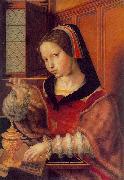 |
Jan van Hemessen
|
|
(c. 1500 - c. 1566) was a Flemish Northern Renaissance painter. He was born in Hemiksem, then called Hemessen or Heymissen. Following studies in Italy, in 1524 he settled in Antwerp. A mannerist, his images focused on human failings such as greed and vanity. Like his daughter, Catarina van Hemessen,he specialised in painted portraits.
Jan Sanders van Hemessen was a Flemish Northern Renaissance painter who was part of the mannerist movement. He was born in Hemessen in the Netherlands but settled in Antwerp in 1524 after studying in Italy. Hemessen specialized in scenes of human character flaws such as vanity and greed.
His pictures are often religious, while his style helped found the Flemish traditions of genre painting. Hemessen was also a portrait painter, which influenced his daughter to become a Flemish Northern Renaissance painter as well. The Surgeon of 1555 is an oil painting by Jan Sanders Van Hemessen currently in the Museo del Prado in Madrid, Spain. The scene likely represents a stonecutter at a fair. The surgeon, who is clearly happy that his operations have been successful, painstakingly moves his knife towards the stone, which is already visible. Behind him hang stones which have been successfully cut out of the head of other patients as a sign of his skill. Next to the quack stands a man who is wringing his hands in desperation, clearly going to be the next patient under the scalpel.
|
|
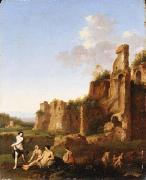 |
Jan van Haensbergen
|
|
(1642-1705) was a Dutch Golden Age painter.
He was registered in the Utrecht Guild of St. Luke in 1668 and in 1669 he was registered in the Confrerie Pictura in The Hague, where he worked until he died.According to Houbraken he was a student of Cornelius van Poelenburgh, and though he was quite successful in imitating his master's style, he switched to portraits since he could make a comfortable living that way.Though he is considered by some to have been born in Utrecht, he signed his name 'Joh. Haensbergh Gorco fecit', which leads historians to conclude he was from Gorinchem. His portraits show the influence of Caspar Netscher.
|
|
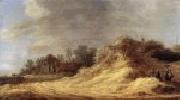 |
Jan van Goyen
|
|
Dutch Baroque Era Painter, 1596-1656
Jan van Goyen was born in Leiden on Jan. 13, 1596. Apprenticed from the age of 10, he had several masters. About 1617 he went to Haarlem to study with Esaias van de Velde, an important innovator in the Haarlem movement of realistic landscape painting. Van Goyen's works between 1621 and 1625 are sometimes hard to distinguish from those of his teacher. They are colorful, detailed views of villages and roads, usually busy with people, as in Winter (1621). It was Van Goyen's usual practice to sign or monogram and date his paintings. He traveled extensively through the Netherlands and beyond, recording his impressions in sketchbooks, occasionally with dates and often depicting recognizable scenes. Thus the chronology of his development is clear. His paintings of the late 1620s show a steady advance from the strong colors and scattered organization of his early works toward tonality and greater simplicity and unity of composition. By 1630 he was painting monochromes in golden brown or pale green; he played a leading part in the tonal phase of Dutch landscape painting. In 1631 Van Goyen settled in The Hague, where he became a citizen in 1634. The simplicity, airiness, and unification of his compositions continued to increase in his abundant production of dune landscapes, river views, seascapes, town views, and winter landscapes. The River View (1636) displays a river so open and extensive as to suggest the sea, with reflections that prolong the vast and luminous sky. In its monumentalization of humble structures and its composition built on a firm scaffolding of horizontal and vertical forces, it forecast at this early date developments that dominated landscape painting in the 1650s and later. In the Village and Dunes (1647) the traditional double-diagonal composition still exists, but it is dominated by horizontal and vertical accents. Stronger contrasts of light and dark replace the earlier tonality. In the last year of his life Van Goyen produced an eloquent new style, in which powerful forms stand out against the radiant sky and water in an exquisitely balanced composition (Evening Calm; 1656). The commission in 1651 to paint a panoramic view of The Hague for the Burgomaster's Room shows the high regard in which Van Goyen was held. He was enormously productive; well over 1,000 of his paintings still exist, and almost as many drawings.
|
|
 |
Jan van Gool
|
|
Johan, or Jan van Gool (1685 - 1763) was a Dutch painter and writer from The Hague, now remembered mainly as a biographer of artists from the Dutch Golden Age.
According to the RKD he learned to paint from Simon van der Does and Mattheus Terwesten. He became a member of the Confrerie Pictura in 1711. He was first regent, and then five years later became director, of the Hague Drawing School from 1720-1734. He spent most of his time in the Hague, but travelled to England twice and is recorded there in 1711. He specialized in Italianate landscapes.
He is best known today for his book of artist biographies, otherwise known as the "Nieuw Schouburg". The full title is De Nieuwe Schouburg der Nederlantsche kunstschilders en schilderessen: Waer in de Levens- en Kunstbedryven der tans levende en reets overleedene Schilders, die van Houbraken, noch eenig ander schryver, zyn aengeteekend, verhaelt worden. (The Hague, 1750).
|
|
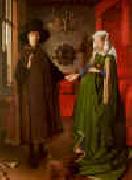 |
Jan Van Eyck
|
|
1395-1441
Flemish
Jan Van Eyck Locations
Painter and illuminator, brother of Hubert van Eyck.
According to a 16th-century Ghent tradition, represented by van Vaernewijck and Lucas d Heere, Jan trained with his brother Hubert. Pietro Summonte assertion (1524) that he began work as an illuminator is supported by the fine technique and small scale of most of Jan works, by manuscript precedents for certain of his motifs, and by his payment in 1439 for initials in a book (untraced) for Philip the Good, Duke of Burgundy. Jan is first documented in The Hague in August 1422 as an established artist with an assistant and the title of Master, working for John III, Count of Holland (John of Bavaria; reg 1419-25), who evidently discovered the artist while he was bishop (1389-1417) of the principality of Liege. Jan became the court official painter and was paid, with a second assistant when the work increased in 1423, continuously, probably until the count death in January 1425.
|
|
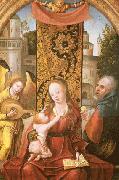 |
Jan Van Dornicke
|
|
was a South Netherlandish painter who was born about 1470 and died about 1527. His first name is sometimes spelled Janssone, and his last name is sometimes spelled van Doornik or van Dornick. He was active in Antwerp from about 1509 to about 1525. His paintings are classified stylistically as Antwerp Mannerism, and he may be the same person as the Master of 1518.
|
|
|
|
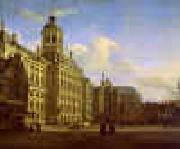 |
Jan van der Heyden
|
|
1637-1712
Dutch
Jan Van Der Heyden Gallery
Van der Heyden grew up in Gorcum, but the family moved to Amsterdam around 1650. They lived on Dam Square. As a young guy he witnessed the fire in the old townhall which made a deep impression on him. He later would describe or draw 80 fires in almost any neighborhood of Amsterdam. When he married in 1661 the family was living on Herengracht, the most fashionable canal in Amsterdam. In 1668 Cosimo II de' Medici bought one of his paintings, a view of the townhall with a manipulated perspective. Van der Heyden often painted country estates, like Goudestein, owned by Joan Huydecoper II. He was not good in drawing figures and used for his paintings a metal plate for bricks, a sponge or moss for the leaves. Johannes Lingelbach, Adriaen van de Velde und Eglon van der Neer assisted him drawing the figures. Jan van der Heyden also introduced the lamp post and in 1672 impoved the design of the fire engine. He died in wealth as the superintendent of the lighting and director of the (voluntary) firemen's guild at Amsterdam.
Van der Heyden was a contemporary of the landscape painters Hobbema and Jacob van Ruisdael, with the advantage, which they lacked, of a certain professional versatility; for, whilst they painted admirable pictures and starved, he varied the practice of art with the study of mechanics. Until 1672 he painted in partnership with Adriaen van de Velde. After Adrian's death, and probably because of the loss which that event entailed upon him, he accepted the offices to which allusion has just been made. At no period of artistic activity had the system of division of labour been more fully or more constantly applied to art than it was in Holland towards the close of the 17th century.
Van der Heyden, who was perfect as an architectural draughtsman insofar as he painted the outside of buildings and thoroughly mastered linear perspective, seldom turned his hand to the delineation of anything but brick houses and churches in streets and squares, or rows along canals, or "moated granges," common in his native country.
He was a travelled man, had seen The Hague, Ghent and Brussels, and had ascended the Rhine past Xanten to Cologne, where he copied over and over again the tower and crane of the great cathedral. But he cared nothing for hill or vale, or stream or wood. He could reproduce the rows of bricks in a square of Dutch houses sparkling in the sun, or stunted trees and lines of dwellings varied by steeples, all in light or thrown into passing shadow by moving cloud.
He had the art of painting microscopically without loss of breadth or keeping. But he could draw neither man nor beast, nor ships nor carts; and this was his disadvantage. His good genius under these circumstances was Adrian van der Velde, who enlivened his compositions with spirited figures; and the joint labour of both is a delicate, minute, transparent work, radiant with glow and atmosphere.
|
|
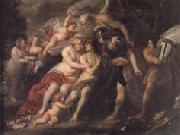 |
Jan Van Den Hoecke
|
|
Flemish Baroque Era Painter, 1611-1651
was a Flemish Baroque painter and draughtsman. He was born and died in Antwerp. He first apprenticed with his father, the painter Gaspar van den Hoecke (1595?C1648); then worked in the studio of Peter Paul Rubens. Jan's brother Robert van den Hoecke (1622?C1668) was also a painter. The artist and his father were well known for their 1635 execution of decorations for the Arch dedicated to the Emperor Ferdinand III in Antwerp. In this collaboration, Jan painted monumental representations, as seen in his piece, Triumphal Entrance of Cardinal Prince Ferdinand of Spain, (Uffizi Gallery). Hoecke then traveled to Austria under the commission of the Emperor Ferdinand III after 1637, staying for about ten years. He also painted for Ferdinand's brother, Archduke Leopold Wilhelm of Austria (1614-C1662), including a Madonna and Child and a number of allegorical pieces. Before this he traveled to Italy and worked in Rome, which may have influenced his style some. Another piece by Hoecke is his, Hercules between Vice and Virtue, (Uffizi Gallery), which shows an influence from both Rubens, and another pupil of the master Baroque painter, Anthony van Dyck.
|
|
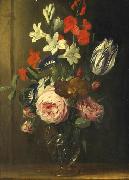 |
Jan van den Hecke
|
|
(1620-1684) was a Flemish Baroque painter.
According to Houbraken he painted landscapes, which he populated with animals and other figures himself. He also made flower and fruit still lifes and could paint gold, silver, crystal, and porcelain quite well. He spent a long period travelling and working in Italy, which is noticeable in his landscapes.
According to the RKD he was registered in the Antwerp Guild of Saint Luke as an apprentice in 1636 and learned to paint from Abraham Hack, who also taught his contemporary, the flower painter Hieronymus Galle. In 1641 Van den Hecke was registered as a master of the guild. From 1653-1658 he was in Italy, but somewhere in the mid-50's he went back and forth to Belgium, since he is also registered in Brussels during that period. He died the same year as his wife Maria Adriana Heijens; when they died they left three children; Jan (II), aged 24, Maria, aged 21, and Peeter, aged 20. Van den Hecke's pupil Peeter de Clerc eventually became a master painter in the guild. Van den Hecke's son Jan van den Hecke II became a popular flower painter.
|
|
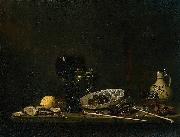 |
Jan van de Velde
|
|
(1593, Delft or Rotterdam-ca. 1 November 1641, Enkhuizen) was a Dutch Golden Age painter and engraver of animal, landscape and still-life subjects. He was the father of the still life painter Jan Jansz van de Velde.
He was apprenticed to engraver Jacob Matham in 1613, entered the Haarlem guild in 1614, and then probably visited Italy. He is better known for his etching and engraving than for his painting. According to Houbraken, he was the brother of Esaias van de Velde and Willem van de Velde the Elder, but according to John Denison Champlin, Esaias was his cousin, and he was no relation at all to the family of Willem.
|
|
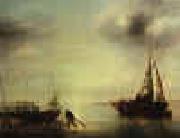 |
Jan van de Cappelle
|
|
1624-1679
Dutch Jan van de Cappelle Locations
Dutch businessman, collector, painter, draughtsman and etcher. Though now considered the outstanding marine painter of 17th-century Holland, he was not a professional artist nor a member of the Amsterdam Guild of St Luke. His father owned a successful dye-works in Amsterdam, in which both Jan and his brother Louis were active. Their father enjoyed a long life and probably managed the firm until close to his death in 1674, when Jan inherited it. This left Jan with plenty of spare time to pursue his hobby, painting. He married Annetje Jansdr. (Anna Grotingh) before 1653. He died a widower, survived by his seven children, who inherited his considerable fortune. His last will shows that in addition to the dye-works and immense cash assets, van de Cappelle owned extensive properties and an art collection that must be rated among the most important of his time.
|
|
|
|
|
|
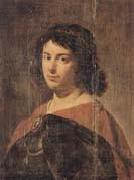 |
Jan van Bijlert
|
|
Dutch Baroque Era Painter, ca.1597-1671
Dutch painter. He was the son of the Utrecht glass painter Herman Beerntsz. van Bijlert (c. 1566-before 1615). Jan must have trained first with his father but was later apprenticed to the painter Abraham Bloemaert. After his initial training, he visited France and travelled to Italy, as did other artists from Utrecht. Jan stayed mainly in Rome, where he became a member of the Schildersbent; he returned to Utrecht in 1624. In Rome he and the other Utrecht artists had come under the influence of the work of Caravaggio; after their return home, this group of painters, who became known as the UTRECHT CARAVAGGISTI, adapted the style of Caravaggio to their own local idiom. The Caravaggesque style, evident in van Bijlert's early paintings, such as St Sebastian Tended by Irene (1624; Rohrau, Schloss; see fig.) and The Matchmaker (1626; Brunswick, Herzog Anton Ulrich-Mus.), is characterized by the use of strong chiaroscuro, the cutting off of the picture plane so that the image is seen close-up and by an attempt to achieve a realistic rather than idealized representation.
|
|
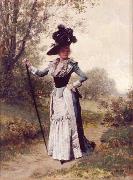 |
Jan van Beers
|
|
(22 February 1821 - 14 November 1888) was Flemish poet born in Antwerp. He is usually referred to as "van Beers the elder" to distinguish him from his son, Jan van Beers, the painter.
Van Beers was essentially a Netherlander, though politically a Belgian, expressing his thoughts in the same language as any North Netherland writer. In fact, the poems of Jan van Beers are perhaps more popular in the Netherlands than in Belgium, and of many of them there exist more editions printed in the Netherlands than in his political fatherland.
Van Beers started life as a teacher of Dutch language and literature, first at Mechelen, then at Lier, and in 1860 was appointed a professor of both at the Athenaeum (high school) in Antwerp, where he had also been a sub-librarian in the communal library. Van Beers as a teacher was early in the field, with Hendrik Conscience, Willems and others, when the Flemish movement began. He composed a Dutch grammar (1852), which, in enlarged editions, still holds the field, and a volume of selections from Dutch authors, both books being so much appreciated that the Belgian government made them text-books in the public schools.
Van Beers's historical poems, the principal of which is, perhaps, Jakob Van Maerlant (Amsterdam, 1860), helped the Flemish revival in Belgium as powerfully as his school-books. He is best known, however, as the writer of ballads and songs. Jongelingsdroomen ("A Young Man's Dreams") first appeared at Antwerp and Amsterdam in 1853. These poems were followed by Levensbeelden ("Life Figures or Pictures," Amsterdam, 1858) and by Gevoel en Leven ("Feeling Living," Amsterdam, 1869). His Rijzende Blaren ("Rising Leaves") first made its appearance at Ghent and Rotterdam in 1883.
|
|
 |
Jan van Goyen
|
|
1596-1656
Dutch
Jan van Goyen Galleries
Dutch landscape painter. He studied at Leiden and Haarlem. In 1631 he settled at The Hague. His typically Dutch landscapes of harbors, canals, riverbanks, and winter scenes with skaters and sleighs are naturalistically painted in a grayish-green tonality. He was one of the first landscape painters to sacrifice minute detail for atmospheric effect and space, and he had a considerable influence on later Dutch landscapists. His paintings are in many collections in Europe and the United States. Famous examples are Panorama of The Hague (The Hague); Banks of a Canal (Louvre); and View of Dordrecht (Rijks Mus.). The Metropolitan Museum has five of van Goyen's works, and the Pennsylvania Academy, two.
|
|
|
|
|
|
|
|
|
| Wholesale China Oil Painting Wholesale Oil Painting China Xiamen Portrait Reproduction on canvas Chinese Oil Painting Wholesale USA Oil Painting |
|
|
|
|
|